Abstract
In this study, some polyethylene/graphene nanoplatelet (PE-GE) composites are successfully prepared via a melt-blending process used for thermally conductive pipes. A comparison study on the effect of different fillers (i.e., graphene nanoplatelet and aluminum oxide) on thermal conductivity is conducted. The conductivity was over 2.5 W/m·K when 30 fractions of GE were involved. Furthermore, an electron beam irradiation technology is utilized to obtain the cross-linked composite materials with excellent comprehensive performance. The relationships between thermal conductivity and filler content, and irradiation dose and gel content have been carefully investigated. Finally, a polyethylene/graphene composite with 0.72 W/m·K is used to extrude a pipe, which exhibits some attractive properties for floor heating pipes.
1. Introduction
Since originating in Europe in 1907 [1], radiant floor heating has been widely used in modern architecture to provide a comfortable and warm environment, especially in the cold winter [2]. The performance and service life of floor heating systems are highly dependent on the quality of pipe materials under the floor. In comparison to some metals, which are easily corrosive under operating circumstances with water, polyolefin polymers, including polyethylene (PE) [3], polypropylene (PP) [4], and polybutylene (PB) [5], possess many attractive properties for application as pipe material. Non-toxic polyethylene pipes are one of the most significant floor heating pipes (FHPs) due to their favorable characteristics such as flexibility, chemical resistance, easy processability, and relatively low cost [3,6]. However, with increasing demands for safety and energy-saving capabilities, the preparation of floor heating pipes with enhanced thermal conductivity, mechanical strength, and long-term stability is becoming a crucial topic [7].
To achieve high heat-transfer efficiency, it is expected for the FHPs to have high thermal conductivity. However, for most polymers (e.g., PE, PP and PB), their thermal conductivities are usually in the range of 0.2~0.4 W/m·K, which cannot meet the performance demands of future FHPs (e.g., > 0.65 W/m·K). It is generally accepted that the incorporation of some high-thermal conductivity fillers into a polymer matrix can efficiently enhance the thermal conductivities of polymers [8]. These thermal conductors include metal elements (e.g., Cu~397 W/m·K, Ag~420 W/m·K, Al~270 W/m·K), inorganic materials (e.g., Al2O3~30–36 W/m·K, BN~400 W/m·K, AlN~320 W/m·K), and carbon materials (e.g., Graphite 119–168 W/m·K, Graphene~5300 W/m·K, Carbon nanotube 3000–3500 W/m·K). Obviously, carbon materials offer a wide range of thermal properties, and graphene and nanotubes are the best conductors to improve the thermal conducting ability of polymers by constructing thermal conducting channels inside the polymeric matrix. For instance, Wu et al. [9] used an alternating current field to orient graphene nanosheets along the electric field in epoxy resin, and their thermal conductivity was increased by 60%. Zeng et al. [10] aligned a composite with a BNNS content of 9.29% in the through-plane direction using the ice template method, and the composite achieved a thermal conductivity of 2.80 W/m·K. Wu et al. [11] developed a high-pressure method to homogenize graphene and carbon nanotubes for thermal conductivity that preserved the large size and minimized defects in the fillers, significantly enhancing the thermal conductivity of PE-RT nanocomposites while simultaneously improving mechanical properties. It should be mentioned that the high cost and difficult mixing process with polymer matrixes of graphene fillers limit their practical and industrial applications, despite their undoubted role in promoting the thermal conductivities of polymer composites.
For use in long-service life FHP applications, the materials must possess sufficiently high mechanical strength, acceptable flexibility, and heat resistance. Thus, some approaches to improve the performance of PE materials have been investigated, and cross-linking is believed to be one of the efficient methods to greatly promote the application performance of PE pipes [12]. Since the PE macromolecular chains form the stable 3D crosslinked interworks after crosslinking reactions, the resistance to pressure and heat of pipes can be rapidly increased. To date, several crosslinking methods, which are suitable for industrial production of PE pipes, have been explored. They are peroxide cross-linking, silane cross-linking, and irradiation cross-linking, corresponding to pipe names as PE-Xa, PE-Xb, and PE-Xc, respectively [13]. Among them, irradiation processes with electron beam (EB) or gamma ray offer the following distinct advantages [14,15]: (1) Crosslinking occurs in the absence of any catalyst, which avoids the residue of small molecules in the products; (2) crosslinking is fast and clean, which is suitable for industrial production; (3) crosslinking degree is precisely controllable by irradiation dosage; and (4) crosslinking reaction can be conducted at room temperature.
In this study, a low-cost industrial-level graphene nanoplatelet (GE) as a thermally conductive filler was successfully introduced into a PE matrix by melt-blending and then, the PE-GE composites were extruded into pipes. Finally, GE-involved PE-Xc pipes were obtained after the EB irradiation process. Some properties of PE-GE composites related to FHP applications were investigated.
2. Materials and Methods
2.1. Materials
Polyethylene granule (LDPE-SP980) was purchased from LG Chem, Seoul, Korea. Its density is 0.938 g/cm3 and its melt flow index is 0.6 g/10min. Polyethylene granule (HDPE-5000S) was purchased from Beijing Yanshan Branch of China Petrochemical Co., Ltd, Beijing, China Its density of HDPE-5000S is 0.951 g/cm3 and its melt flow index is 1.0 g/10 min. Graphene nanoplatelets were obtained from Liaoning Maifang Carbon Technology Co., Ltd, Liaoning, China. (The number of graphene sheet layers is 10–20 and the sheet diameter is 40–50 μm). Trimethylolpropane trimethacrylate (TMPTA) was obtained from Shanghai Aladdin Bio-Chem Technology Co., Ltd, Shanghai, China. Ethanol and other chemicals were obtained from commercial sources.
2.2. Instruments and Measurements
The mechanical properties were tested by universal testing the machine (AG-20 KN) at room temperature with a tensile rate of 100 mm/min. The thermal stability was evaluated in air by the thermogravimetric instrument (METTLER TGA2). The test temperature range was 100–600 °C and the temperature increase rate was 10 °C/min. The test samples were made according to the test, and the thermal diffusion coefficient and specific heat of the samples were obtained by instrument testing. Thermal conductivity measurements were conducted with a Netzsch LFA 467 HyperFlash instrument. The Vicat temperature of the sample was measured with a thermal deformation (CEAST HV500) and Vicat temperature tester to determine the softening temperature of the material and the upper limit of the service temperature. A field emission electron scanning microscope (Nova nano 450) was used to observe the microstructure of the surface and quenched cross-section of the composites, and the particle size and distribution of the thermal conductive fillers were observed. The equipment used in this study was sourced from Key Laboratory of High Performance Plastics of the Ministry of Education, Changchun, China. The extrusion line of pipes was provided by Jilin Jifu New Materials, Co., Ltd, Changchun, China. The pressure test machine (MTSH-6) was used to test the hydrostatic resistance of extruded pipes. The type of electron accelerator is an AB3.0–30 high-frequency and high-voltage electron accelerator, and the accelerator parameter has a high voltage of 2.5 MeV. The irradiation speed was 25 m/min and irradiation doses were 100–190 KGy.
2.3. Preparation of PE-GE Composites
The dried graphene nanoplatelet was put into a high-speed mixer, followed by adding the ethanol–water solution containing silane coupling agent (vinyltriethoxysilane). After heating, high-speed stirring, and drying, the surface-modified GE particles were obtained.
Two grades of polyethylene (PE) were selected as the matrix of the floor heating pipes. According to the ratio of HDPE: LDPE = 4:1, the two grades of PE resins were weighed and mixed thoroughly. The graphene-doped polyethylene composites were prepared by melting and blending of the PE matrix and GE filler in a single-screw extruder, and they were named as PE-GE-X (X is the amount of thermal conductive filler added). The temperatures were set to 190, 190, 195, and 200 °C in four extrusion steps. The PE-GE pipes with 20 mm of outer diameter and 2 mm of wall thickness were produced.
2.4. EB-Irradiation Process of the Pipes
The sheets and pipes were irradiated with a high-energy electron beam by an AB3.0–30 high-frequency and high-voltage electron accelerator. The irradiation doses were 100, 130, 160, and 190 kGy.
3. Results
3.1. Graphene Surface Modification for Improved Processability of Composites
Despite its excellent strength and high thermal conductivity, the chemical inertness of the graphene filler leads to its extremely hard uniform dispersity in the polymer matrix. Usually, graphene filler can be incorporated into the polymer matrix to prepare polymer-GE composites through solution casting [16], melt-blending [17], and in situ polymerization [18]. Melt-blending of the GE and polymer is more difficult, but it is attractive for a large-scale preparation in industry. In this study, to avoid its agglomeration occurrence and increase the interaction between the GE filler and PE matrix, a surface modification of GE filler by treating in vinyl triethoxysilane surfactant was adopted. And, through a melt-blending process, a series of PE-GE composites with different GE contents were achieved for property investigation and pipe fabrication. To obtain a good balance of flexibility and strength, a mixture of high-density PE and low-density at a ratio of 4:1 was selected as a continuous phase of the composites.
3.2. A Comparison Study on the Thermal Conductivity of PE-GE and PE-Al2o3
In our previous study, aluminum oxide (Al2O3) particles were introduced into the PE matrix to enhance thermal conducting capacity [19]. However, to obtain a sample with a conductivity of ~0.5 W/m·K, almost 40 mass fractions of Al2O3 particles had to be combined, leading to an increase in density and a loss of flexibility. It is a research direction for the composites to have a high thermal conductivity at a relatively low-addition level of heat conductors. As illustrated in Figure 1A, with the additional increase in the graphene nanoplatelet in PE, the thermal conductivity of PE-GE composites showed an upward trend. At 15 fractions of GE fillers in the PE matrix (set to 100 fraction), the thermal conductivity reached 0.72 W/m·K, which was twice as much as pure PE (~0.36 W/m·K). Obviously, this thermal conductivity value is desired for its application as floor heating pipes. Its thermal conductivity was over 2.5 W/m·K when 30 fractions of the GE were involved. As an obvious comparison, Al2O3 particle-filled PE composites (PE-Al2O3) did not express any upward turning point in the thermal conductivity curve, and their thermal conductivities remained around 0.4 W/m·K at the range of a 10–30 fraction of Al2O3 particles. To obtain the same thermal conductivity values (e.g., 0.5, 0.6, 0.7, and 0.8 W/m·K), different additional fractions of the GE and Al2O3 were needed (Figure 1B). To achieve 0.6 W/m·K, 90 fractions of Al2O3 particle had to be incorporated; however, only 12 fractions of GEs were enough. These results clearly illustrate the effect of different fillers on the thermal conductivity of PE composites.
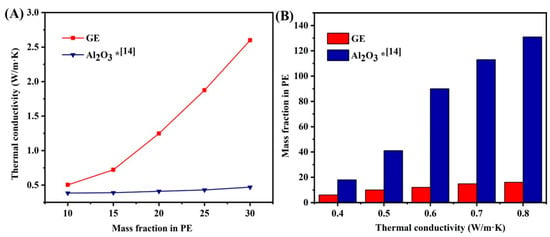
Figure 1.
Thermal conductivities of PE-GE and PE-Al2O3 composites: (A) Relationship between conductivity and filler content; (B) A comparison chart of different fillers.
3.3. Crosslinking Process Under EB Irradiation
For PE-based materials, the crosslinking reactions between PE molecular chains can occur under high-energy EB irradiation [20,21]. In this study, a mixture of two kinds of PE resins was used as the matrix. To promote crosslinking efficiency, trihydroxymethyl propane triacrylate (TMPTA) was introduced as the irradiation sensitizer. The relationship between the gel content (e.g., crosslinking degree) and irradiation dose of the composites is shown in Figure 2. For all the samples, gel content values always grew with increased irradiation doses in the range of 100–160 kGy. However, at a higher dose of 190 kGy, the growth rate of gel content decreased or negative growth occurred. This might be related to the possible degradation of PE molecular chains at high-energy irradiation. Importantly, the existence of TMPTA could play a crucial role in the enhancement of crosslinking. It was observed that the gel content of the composite material with only two parts of the TMPTA irradiation sensitizer could reach more than 60%. Moreover, with the increase in TMPTA content, the cross-linking degree of the composites also showed an upward trend. After comprehensive consideration, two portions of TMPTA and 130 kGy of irradiation doses were selected as optimal conditions for this system.
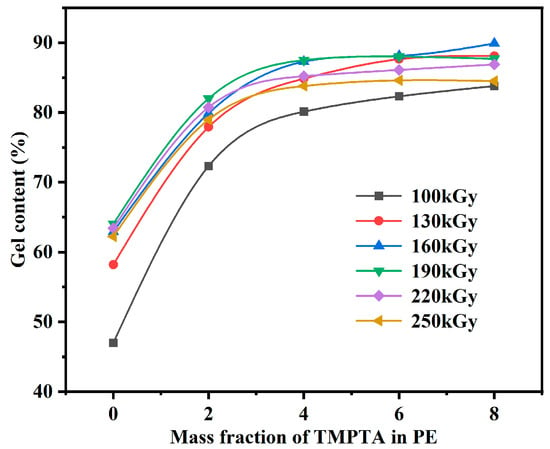
Figure 2.
Gel contents of PE matrix with different portions of irradiation sensitizer.
For an understanding of the crosslinking reactions occurring in PE chains, the crosslinking effects with or without TMPTA are suggested in Figure 3. Due to the multi-arm structure of TMPTA small molecules, they can generate rich free radicals even at a low irradiation dose. These free radicals will attend the crosslinking reactions of PE chains, which also yield many free radicals after irradiation. Obviously, TMPTA molecules bring about more crosslinking points, promoting the cross-linking degrees and stability of the 3D crosslinked structure.
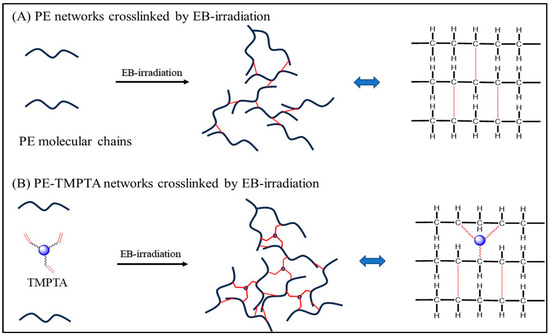
Figure 3.
Crosslinking diagrams of PE molecules without (A) or with (B) TMPTA.
3.4. Mechanical Properties of PE-GE Composites
The pipe applications require the materials to have enough flexibility and strength. Usually, the incorporation of the fillers into the PE matrix may have a great influence on the mechanical properties of the composites. Especially, a higher content of fillers (e.g., inorganic and organic particles) often damage the flexibility and some other properties of PE-based composites [22,23]. As illustrated in Figure 4A, the tensile strength and tensile strain slightly decreased when adding GE fillers. It is worthy to mention that the PE-GE composites containing 5–20 portions of GE fillers had a good combination of strength and strain. At ambient temperature, their tensile strengths were 27.06 MPa and tensile strains were 361%. After considering the thermal conductivity data, PE-GE-15, with a tensile strength of 27 MPa and an elongation at break of 361%, was selected as the sample for further investigation (Figure 4A).
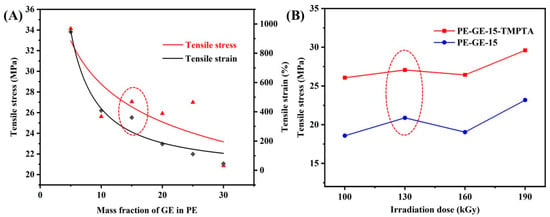
Figure 4.
(A) Mechanical properties of PE-GE composites with different GE contents; (B) Mechanical properties of PE-GE composites (with or without TMPTA) crosslinked at different irradiation dosages.
A reasonable increase in crosslinking points and degrees may be helpful for the improvement of the mechanical properties of PE-based materials. In this study, an investigation of the effect of irradiation sensitizers on mechanical properties was conducted. PE-GE-15 composites containing TMPTA or not under various irradiation dosages were prepared and their mechanical properties were tested (Figure 4B). Firstly, for each series, the test results clearly revealed the positive correlation between the irradiation dose and maximum stress. With the irradiation dose, the maximum stress of composites also shows a corresponding upward trend. Further observation showed that under the same irradiation dose conditions, the series containing the irradiation sensitizer showed a more significant improvement in strength. For instance, the stress value of PE-GE-15-TMPTA was 27.06 MPa, which was 29.6% higher than PE-GE-15 without the irradiation sensitizer. Based on this finding, it can be reasonably inferred that the adjustment of cross-linking points and degrees is a key factor in strengthening the mechanical properties of these composites. Finally, PE-GE-15-TMPTA with irradiation at 130 kGy exhibited promising features for pipes.
For a fair evaluation of overall performance of some reported samples, the relationship diagrams of thermal conductivity versus stress and strain are drawn in Figure 5A and Figure 5B, respectively. An ideal sample, which simultaneously possesses higher conductivity and a higher mechanical performance, is located in the right-hand corner. By comparing the data of the composites containing different conducting fillers, one could say that the overall performance of PE-GE composites surpassed most of the reported samples [24,25]. This means that PE-GE-15 might be a promising high thermally conductive material for pipes.
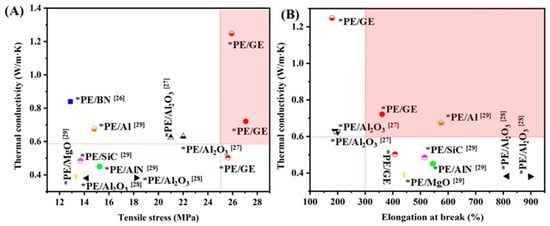
Figure 5.
Comparison of thermal conductivity of different thermal conductive fillers. (A) Thermal conductivity vs. tensile stress; (B) Thermal conductivity vs. elongation at break [26,27,28,29].
3.5. Thermal Properties of PE-GE-15
Figure 6A displays the relationship between Vicat softening temperature (VST) and irradiation doses of the PE-GE-15 sample. It can be clearly seen that the cross-linking degree related to irradiation dose has a positive effect on the VST. All the EB-treated samples possessed VSC values ranging from 131 °C to 135 °C, which was much higher than 121 °C of PE-GE-15 without irradiation. This revealed that the PE-GE-15 sample after treating at 100–190 kGy doses could well meet the requirement of heat floor pipes (operating temperature is 60~80 °C).
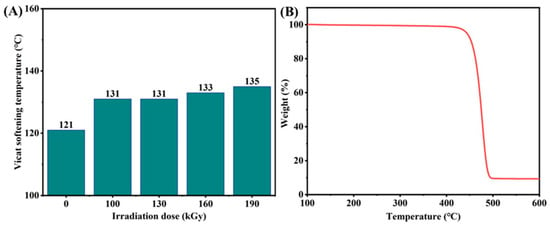
Figure 6.
Thermal properties of PE-GE-15. (A) Vicat softening temperatures at different irradiation doses; (B) TGA curve after treating at 130 kGy.
To further characterize the thermal stability of PE-GE-15 at 130 kGy, a thermogravimetric test was carried out in air. As shown in Figure 6B, the composite had no significant weight loss below 400 °C, indicating its acceptable thermal stability.
3.6. Microscopic Morphology
SEM results proved that pure graphene nanoplatelets exhibited a multi-layer sheet-like structure (Figure 7A). The surface of PE-GE-15 at 130 kGy did not show any obvious wrinkles and fractures, indicating good interactions between GE fillers and the PE matrix. It can be seen that with the increase in GE fractions, the quenched sections of PE-GE composites gradually transitioned from a non-layered to layered structure (Figure 7C–F). For the PE-GE-15 sample, it finally formed a uniformly distributed layered structure. This phenomenon further suggested that the graphene after surface treatment with A151 could well disperse in the PE continuous phase. With the increase in GE content, the integrity of the thermal conduction path gradually formed, as pointed out in red arrows (Figure 7E,F). These results could explain the reason why PE-GE-15 and PE-GE-30 had high thermal conductivities.
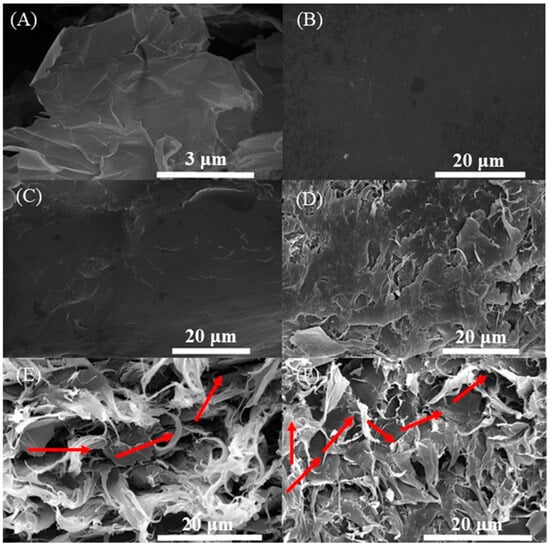
Figure 7.
SEM photos: (A) Pure graphene; (B) PE-GE-15–130 surface; Cross sections at GE fractions of (C) 0%, (D) 5%, (E) 15%, and (F) 30%.
3.7. Fabrication of the PE-GE-15 Pipes
According to the above research results on the structure and performance of PE-GE composites, PE-GE-15 was selected for batch preparation and pipe fabrication. To obtain qualified pipes, a small amount of antioxidants and other processing aids were involved. As illustrated in Figure 8A, through mixing and granulation, pipe extrusion, and irradiation modification processes, smooth and flexible graphene-involved PE-based pipes (PE-Xc) with high thermal conductivity were successfully fabricated. The illustration of highly thermal conducting pipes with cross-linked structure is shown in Figure 8B. Furthermore, the quality of the pipes was carefully evaluated, and they pass the examinations of hydrostatic resistance tests (e.g., 20 °C,12 Mpa, 1 h and 95 °C, 4.8 Mpa, 22 h).
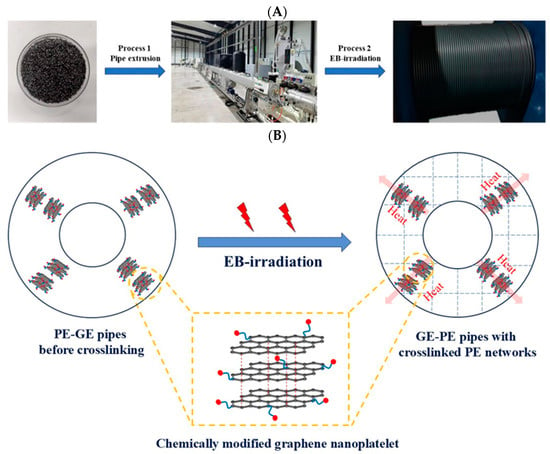
Figure 8.
(A) Fabrication processes of EB-irradiated PE-GE-15 pipes; (B) Illustration of highly thermal conducting pipes with cross-linked structure.
4. Conclusions
In this work, through the careful study of the thermal conductivity, mechanical strength, and thermal properties of PE-GE composites, a new kind of PE-based material for thermal conducting pipes was achieved. It possessed better comprehensive performance in comparison to some reported thermal conduction materials. After EB-irradiated crosslinking modification, its thermal conductivity could reach 0.72 W/m·K, which was an increase of 0.33 W/m·K compared with Al2O3 filler under the same mass fraction. PE-GE-15 had a tensile stress of 27.06 MPa and an elongation at break of 361%. The study also found that the sensitizer was greatly helpful to the improvements in the cross-linking process. The stress value of PE-GE-15-TMPTA was 27.06 MPa, which was 29.6% higher than PE-GE-15 without the irradiation sensitizer. Finally, PE-GE-15 was successfully fabricated into the pipes and passed the static hydrostatic tests. All the studies suggest that these high-performance PE-GE composites are promising thermal conductive materials for floor heating pipes.
Author Contributions
Conceptualization, B.L. and W.X.; methodology, B.L.; software, K.L.; validation, Y.L., C.X., and K.L.; formal analysis, K.L.; investigation, H.L.; resources, W.X.; data curation, K.L.; writing—original draft preparation, K.L.; writing—review and editing, B.L.; visualization, H.L.; supervision, B.L.; project administration, W.X.; funding acquisition, Y.L. All authors have read and agreed to the published version of the manuscript.
Funding
This research was funded by the Science and Technology Development Plan of Jilin Province, China, grant number 20220201116GX.
Data Availability Statement
The data supporting the conclusions of this article are available on request from the corresponding author.
Conflicts of Interest
Authors Wenge Xu and Yang Liu were employed by the company R & D Department, Changchun CNNC CIRC Radiation Technology Co., Ltd. The remaining authors declare that the research was conducted in the absence of any commercial or financial relationships that could be construed as a potential conflict of interest.
References
- CIBSE HVUH. Underfloor Heating Design & Installation Guide; Chartered Institution of Building Services Engineers: London, UK, 2016; ISBN 9781906846824. [Google Scholar]
- Meng, X. Thermal performance assessment of the dynamic rotating latent-energy-storage envelope (DRLESE) during winter. Case Stud. Therm. Eng. 2024, 60, 104671. [Google Scholar] [CrossRef]
- Scheirs, J.; Böhm, L.L.; Boot, J.C.; Leevers, P.S. PE100 Resins for Pipe Applications:-Continuing the Development into the 21st Century. Trends Polym. Sci. 1996, 4, 408–415. [Google Scholar]
- Hametner, C. Polypropylene pipes for drinking water supply. J. Macromol. Sci. Part A 1999, 36, 1751–1758. [Google Scholar] [CrossRef]
- Crowson, D.L.; Chambers, R. Polyethylene and polybutylene pipe and tubing: A status report. J. Am. Water Work. Ass. 1985, 77, 45–46. [Google Scholar] [CrossRef]
- Bohm, L. The Ethylene Polymerization with Ziegler Catalysts: Fifty Years after the Discovery. Angew. Chem. Int. Ed. 2003, 42, 5010. [Google Scholar] [CrossRef]
- Hou, Z.L.; Wei, W.J. Market analysis for PERT floor heating tube specialty. China Synth. Resin Plast. 2019, 36, 90–93. [Google Scholar]
- Zhou, X.Y.; Qin, M.M.; Feng, W. Enhancing thermal conductivity of polymer matrix composite by optimizing filler structure. J. Funct. Polym. 2024, 37, 295–303. [Google Scholar]
- Wu, S.; Ladani, R.B.; Zhang, J. Aligning multilayer graphene flakes with an external electric field to improve multifunctional properties of epoxy nanocomposites. Carbon 2015, 94, 607–618. [Google Scholar] [CrossRef]
- Zeng, X.L.; Yao, Y.M.; Gong, Z.Y.; Wang, F.F.; Sun, R.; Xu, J.B.; Wong, C.P. Ice-templated assembly strategy to construct 3D boron nitride nanosheet networks in polymer composites for thermal conductivity improvement. Small 2015, 11, 6205–6213. [Google Scholar] [CrossRef]
- Wu, H.C.; Zhou, W.Q.; Liu, Q.; Cai, X.; Qu, Z.H.; Li, P.; Hu, D.; Jia, X. High pressure homogenization of graphene and carbon nanotube for thermal conductive polyethylene composite with a low filler content. J. Appl. Polym. Sci. 2022, 139, 51838. [Google Scholar] [CrossRef]
- Pi, L.; Guo, D.; Nie, M.; Wang, Q. Highly endurable hydrostatic pressure polyethylene pipe prepared by the combination of rotation extrusion and lightly cross-linked polyethylene. J. Polym. Res. 2018, 25, 177. [Google Scholar] [CrossRef]
- Dadbin, S.; Frounchi, M.; Sabet, M. Studies on the properties and structure of electron-beam crosslinked low-density polyethylene/poly[ethylene-co-(vinyl acetate)] blends. Polym. Int. 2005, 54, 686–691. [Google Scholar] [CrossRef]
- Shi, C.Y.; Yang, J.Y.; Liu, Y.; Wang, Y.M.; Xu, W.G.; Xu, Y.Q.; Hu, W.; Liu, B.J. Thermally conductive study of polyethylene/Al2O3 composite networks cross-linked by electron beam irradiation. Chem. Res. Chin. Univ. 2020, 36, 940–945. [Google Scholar] [CrossRef]
- Salehi, S.M.A.; Mirjalili, G.; Amrollahi, J. Effects of high-energy electron beam on low-density polyethylene materials containing EVA. Appl. Polym. Sci. 2004, 92, 1049–1052. [Google Scholar] [CrossRef]
- Seretis, G.V.; Kouzilos, G.; Polyzou, A.K.; Manolakos, D.E.; Provatidis, C.G. Effect of graphene nanoplatelets fillers on mechanical properties and microstructure of cast aluminum matrix composites. Nano Hybr. Compos. 2017, 15, 26–35. [Google Scholar] [CrossRef]
- Mohammad, W.M.W.; Ali, E.; Ghapur, E.A.; Abdullah, M.A.A.; Sheng, C.K. Investigation on mechanical, electrical and morphological of high-density polyethylene (HDPE) reinforced with different particle size and composition of graphene nanoplatelets (GNP). Dig. J. Nanomater. Biostructures 2024, 19, 41–52. [Google Scholar] [CrossRef]
- Zhang, C.; Li, A.; Zhao, Y.H.; Bai, S.L.; Zhang, Y.F. Thermal, electrical and mechanical properties of graphene foam filled poly (methyl methacrylate) composite prepared by in situ polymerization. Compos. Part. B-Eng. 2018, 135, 201–206. [Google Scholar] [CrossRef]
- Ouyang, Y.G.; Bai, L.Y.; Tian, H.F.; Li, X.F.; Yuan, F.L. Recent progress of thermal conductive ploymer composites: Al2O3 fillers, properties and applications. Compos. Part A Appl. Sci. Manuf. 2022, 152, 106685. [Google Scholar] [CrossRef]
- Sabet, M.; Hassan, A.; Ratnam, C.T. Mechanical, electrical, and thermal properties of irradiated low-density polyethylene by electron beam. Polym. Bull. 2012, 68, 2323–2339. [Google Scholar] [CrossRef]
- Gheysari, D.J.; Behjat, A.; Haji-Saeid, M. The effect of high-energy electron beam on mechanical and thermal properties of LDPE and HDPE. Eur. Polym. J. 2000, 37, 295–302. [Google Scholar] [CrossRef]
- Kherici, S.; Benouali, D.; Nouredine, C. The effects of calcium carbonate filler on HDPE pipe. Adv. Sci. Technol. 2022, 16, 213–218. [Google Scholar] [CrossRef]
- Dimitra, K.; Evangelia, T.; Bikiaris, D.N.; Konstantinos, C. Thermal properties of graphene nanoplatelets reinforced crosslinked and short chain branched polyethylenes for geothermal pipe applications. Macromol. Symp. 2022, 405, 2100225. [Google Scholar]
- Khanam, P.N.; Al-Maadeed, M.A.; Ouederni, M.; Harkin-Jones, E.; Mayoral, B.; Hamilton, A.; Sun, D. Melt processing and properties of linear low density polyethylene-graphene nanoplatelet composites. Vacuum 2016, 130, 63–71. [Google Scholar] [CrossRef]
- Balandin, A.A.; Ghosh, S.; Bao, W.Z.; Calizo, I.; Teweldebrhan, D.; Miao, F.; Lau, C.N. Superior thermal conductivity of single-layer graphene. Nano Lett. 2008, 8, 902–907. [Google Scholar] [CrossRef] [PubMed]
- Yang, J.J.; Wang, C.; Zhou, S.L.; Zheng, M.; Ye, H.Y. Preparation and performance of thermal conductive composite of polyethylene/graphene/boronnitride. Technol. Dev. Chem. Ind. 2022, 51, 15–85. [Google Scholar]
- Duan, J.C.; Qi, Y.X.; Shi, C.Y.; Zhao, Q.; Liu, B.J.; Sun, Z.Y.; Xu, Y.Q.; Hu, W.; Zhang, N.N. Electron beam radiation modification of polyethylene thermal conductive composites. J. Appl. Chem. 2020, 37, 896–903. [Google Scholar]
- Shi, H.C.; Yu, Y.C.; Han, C.Y. Morphology, rheological and mechanical properties of polyethylene/aluminium oxide composites. J. Appl. Chem. 2022, 39, 1593–1599. [Google Scholar]
- Gu, Y.X.; Song, Y.B.; Qiao, L.Q.; Zhang, W.L.; Gui, J.F. Effects of thermal conducting fillers on properties of LLDPE. Plast. Sci. Technol. 2015, 43, 86–89. [Google Scholar]
Disclaimer/Publisher’s Note: The statements, opinions and data contained in all publications are solely those of the individual author(s) and contributor(s) and not of MDPI and/or the editor(s). MDPI and/or the editor(s) disclaim responsibility for any injury to people or property resulting from any ideas, methods, instructions or products referred to in the content. |
© 2025 by the authors. Licensee MDPI, Basel, Switzerland. This article is an open access article distributed under the terms and conditions of the Creative Commons Attribution (CC BY) license (https://creativecommons.org/licenses/by/4.0/).